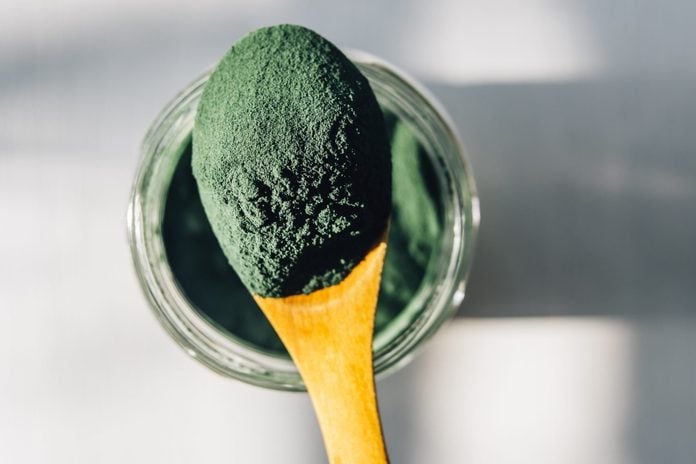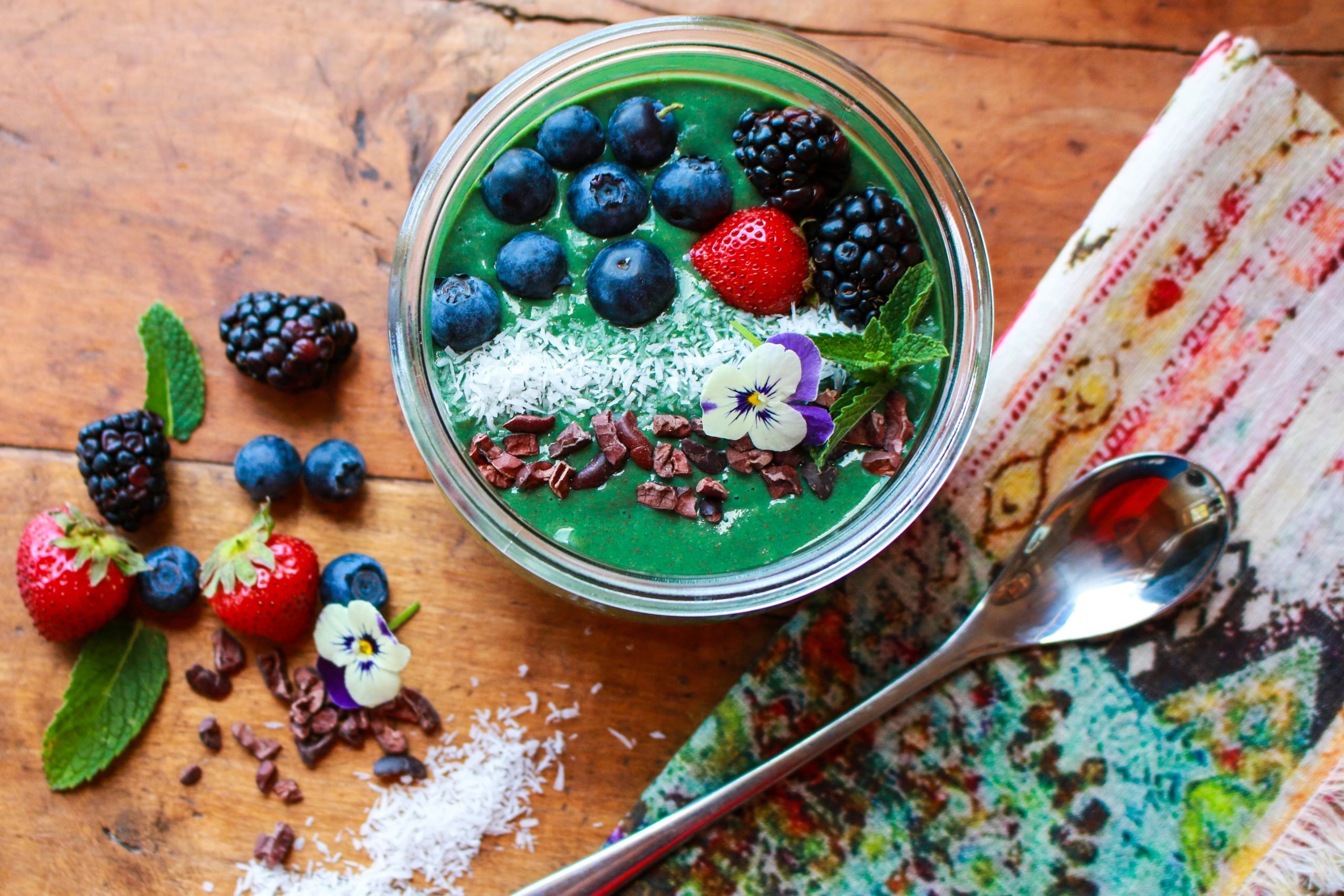What You Should Know About Spirulina Benefits, Nutrition, and More

Spirulina is a blue-green algae often touted for its health benefits and used in smoothies. Here's what to know about its nutrition, including the calories, protein, iron, and more.
Spirulina, or blue-green algae, is a popular smoothie ingredient due to its list of potential health benefits. It’s a tiny spiral-shaped type of cyanobacteria that’s found naturally in some freshwater ponds and saltwater lakes, says Sharon Palmer, a registered dietitian nutritionist in Ojai, California, and author of California Vegan. It can also be grown in man-made lakes and in labs. From there, it is harvested and freeze-dried. “It’s been used for years as a food source, even back to ancient times,” Palmer says.
The lush blue-green color comes from the antioxidant phycocyanin, which is found in abundance in spirulina. The Food and Drug Administration (FDA) allows manufacturers to use spirulina as a color additive for gum and other packaged foods. But it’s got more than just looks going for it. “Spirulina is impressive, as you can get a lot of nutritional oomph in as little as a tablespoon,” says Lauren Slayton, a New York City–based dietitian, founder of nutrition-training service Foodtrainers, and author of The Little Book of Thin.
(Related: These are the Best Plant-Based Sources of Vegan Protein)
Spirulina nutrition facts
One tablespoon (7 g) of spirulina contains:
- Calories: 20
- Protein: 4 grams (8 percent of the daily value, or DV, for a 2,000 calorie daily diet)
- Fat: 1 gram (1 percent DV)
- Carbohydrates: 2 grams (1 percent DV)
- Fibre: 0.3 g (1 percent DV)
- Iron: 2 mg (13 to 22 percent DV)
- Magnesium: 13.6 mg (3.4 percent DV)
- Potassium: 95.4 mg (3 to 4 percent DV)
Spirulina is also a source of B vitamins, beta-carotene, copper, and other nutrients. It contains chlorophyll, an antioxidant and the pigment that gives plants their green color. You may remember from biology class that plants use chlorophyll with sunlight to make their own food—a process known as photosynthesis.
(Related: 12 Collagen Supplements and Where to Buy Them in Canada)
Spirulina’s potential health benefits
The nutrients in spirulina work together to promote health and well-being, says Slayton. The protein content in particular helps spirulina stand out from the pack—it’s a better source of protein than some veggies.
Helps boost iron levels
Anemia occurs when you don’t have enough healthy red blood cells to carry oxygen throughout your body, and it can leave you feeling zapped of all energy. Iron deficiency is a common cause of anemia. “Because of its iron content, spirulina is great for anemia,” Slayton says.
Iron supplements may cause stomach upset, constipation, diarrhea, and nausea. Spirulina doesn’t carry the same side effects, making it a good iron alternative. If your doctor has recommended an iron supplement, discuss your options together before treating with spirulina.
May reduces dental plaque and inflammation
Gum disease and poor oral health have been linked to heart disease, diabetes, and stroke; this process starts with a buildup of sticky plaque on your teeth and ultimately causes inflammation in your gum line and elsewhere in your body.
Likely due to its anti-inflammatory properties, spirulina mouthwash may help reduce dental plaque and inflammation, according to a study in the International Journal of Pharmacy and Pharmaceutical Sciences. Considering the study lasted only a week, more research is needed to see if spirulina mouthwash might have long-term benefits. The American Dental Association says brushing your teeth, flossing, and seeing your dentist for cleanings are the best ways to prevent gum disease.
(Related: 5 Meal Prep Tips for People Who Are Vegans or Vegetarians)
May help seasonal allergies
If you are one of the millions of people plagued by the sniffling and sneezing of seasonal allergies, spirulina may help. One study suggested that spirulina may be more effective than a common anti-allergy pill, possibly because its inflammatory properties block the release of histamines when you encounter a potential allergen. These findings appear in a 2020 issue of ACTA Otorhinolaryngologica Italica. Still, the National Center for Complementary and Integrative Health cautions that there is not enough evidence to support its use for seasonal allergies.
May help protect against oral cancer
Some older studies have found potential protective effects of spirulina on oral cancer. In one, published in 2013 in the Journal of Clinical and Diagnostic Research, participants with precancerous lesions were randomly assigned to take spirulina or a prescription drug for improving blood flow. After three months, the spirulina users had a greater improvement in symptoms than those who took the medication.
In a 1995 study published in Nutrition and Cancer, researchers looked at its effect on tobacco chewers with precancerous lesions. After a year of taking one gram of spirulina per day, 45 percent of participants saw their lesions go away, compared with only seven percent of people who took a placebo. It’s still too early to say for sure whether spirulina has anticancer properties, for oral or any other type of cancer. More research is needed to explore the theory.
May help weight loss and heart health
Consuming spirulina may help you win the battle of the bulge and lower your risk for heart disease to boot, according to a review article in the 2020 issue of Open Heart. The research suggested that taking 2 to 8 grams of spirulina per day may aid weight loss and lower levels of “bad” low-density lipoprotein (LDL) cholesterol, dangerous blood fats known as triglycerides, and blood pressure—all while improving “good” high-density lipoprotein (HDL) cholesterol.
Exactly how spirulina does all of these things is not fully understood, but researchers suggest it may leave you feeling fuller faster, cool inflammation, and help escort bad cholesterol out of your body. Still, they caution, more studies are needed to confirm these benefits.
(Related: 6 Things You Probably Don’t Know About Heart Health)
May help manage diabetes
Taking spirulina supplements may lower fasting blood sugar, or glucose, a sign it may help manage diabetes, according to a 2018 meta-analysis published in Diabetes, Metabolic Syndrome and Obesity: Targets and Therapy. It’s worth one of the study’s weaknesses: Not all of the studies reviewed in this paper included participants with diabetes.
(These are the best and worst drinks for people with diabetes.)
Spirulina types and varieties
There are many different spirulina species, only some of which are identified on labels of products. Spirulina maxima and Spirulina platensis are the most popular. And these come in tablet, capsule, or powdered forms. No matter which type you use, be sure to buy from a reputable company. It’s possible for spirulina supplements to contain contaminants, Slayton says.
Risks and side effects of eating spirulina
Spirulina is not recommended if you are pregnant or if you have a known autoimmune condition, such as lupus or rheumatoid arthritis, Slayton says. It could stimulate your immune system and make your condition worse.
Don’t use spirulina if you have phenylketonuria (PKU), a metabolic disorder in which your body can’t metabolize phenylalanine. Plus, it could be contaminated with a liver toxin called microcystin or a brain toxin called neurotoxin β-N-methylamino-L-alanine (BMAA), according to Consumer Lab, an independent supplement-testing organization based in White Plains, New York.
It’s a good idea to tell your doctor about everything you’re taking, including supplements, as they could interact with medications.
(Related: What You Need to Know Before Taking Biotin Supplements)
What does spirulina taste like?
While spirulina is nutritious, it’s not super delicious. You can down it in capsule or tablet form and avoid tasting it altogether. Or you can try a spirulina powder, which you’ll want to pair with other flavors. “You can use it in smoothies [or] dressings, or you can always take it in pill form,” Slayton says. “It has a grassy, earthy taste,” adds Palmer. “It’s good in smoothies, puddings, and porridges.”
Spirulina dosage
Because spirulina isn’t well-studied, there are no recommendations about how much is too much or too little. “We don’t know based on research what safe amounts are, but I would recommend one tablespoon as a serving,” Palmer says.
Spirulina recipe
Ready to try spirulina? Palmer recommends her vegan Mermaid Smoothie Bowl, which includes a half teaspoon of spirulina powder. Get the recipe below.

Mermaid smoothie bowl
Ingredients
- 2 small bananas, peeled
- 1 large orange, peeled
- 2 tablespoons chia seeds
- ½ teaspoon spirulina powder
- ¼ cup unsweetened plant-based milk, such as soy
- 1 teaspoon vanilla
Toppings
- 1 teaspoon shredded coconut
- 1 teaspoon cocoa nibs
- ¼ cup fresh berries
Instructions
- Place bananas, orange, and chia seeds into a small blender.
- Add in spirulina, plant-based milk, and vanilla.
- Process until smooth and creamy. This should take a few seconds.
- Pour into a large bowl and garnish with shredded coconut, cocoa nibs, and berries.
- Chill until serving time.
The last word
Spirulina may not be tasty, but it can pack a powerful nutritional punch and may have some important health benefits as a result. Still, more research is needed to support its role in preventing any diseases. “Studies show that it has antioxidant activity that can reduce inflammation and enhance immunity,” Palmer says. “We don’t have enough research on disease yet, but it potentially could help in reducing inflammation as part of a healthy diet and lifestyle.”
If you want to try spirulina, choose a reputable brand and don’t take more than one tablespoon at a time. Always let your doctor know about any supplements you are adding to your diet.
Now that you know about the health benefits of spirulina, this is what you need to know about soy.




